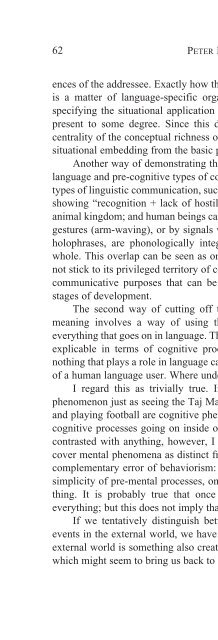Cognitive Semantics : Meaning and Cognition
Cognitive Semantics : Meaning and Cognition
Cognitive Semantics : Meaning and Cognition
Create successful ePaper yourself
Turn your PDF publications into a flip-book with our unique Google optimized e-Paper software.
SPACE AND TIME 133<br />
visual perception <strong>and</strong> of data from descriptions of spatial layout.<br />
2. Time lines in spoken languages<br />
There is a considerable amount of literature on time expressions in spoken<br />
languages, especially on temporal expressions that seem to be derived from<br />
expressions of spatial relations such as the words <strong>and</strong> phrases in bold in the<br />
following examples.<br />
(1) a. The worst is behind us. back = earlier<br />
b. I am looking ahead to meeting her. front = later<br />
(2) a. in the following years back = later<br />
b. in the preceding years front = earlier<br />
(3) a. Il venait de fermer la porte. come = earlier<br />
[lit. He came from closing the door =]<br />
‘He had just closed the door.’<br />
b. He was going to do it. go = later<br />
(4) a. in the coming years come = later<br />
b. in the years gone by go = earlier<br />
The spatial concept underlying the expressions in (1) is one of an individual<br />
placed in the middle of time <strong>and</strong> facing the future. Events earlier in time are<br />
conceptualized as being behind the individual, while events later in time are<br />
conceptualized as being in front of the individual. The spatial idea behind the<br />
expressions in (2) is that of years in a line approaching an individual such that<br />
all of the years are in front of the individual. The first years in the line precede<br />
the later years when approaching the individual, i.e. ‘front’ is correlated with<br />
earlier in time; the following years are behind the preceding years <strong>and</strong> thus<br />
later in time, i.e. ‘back’ (behind the preceding years) is correlated with later in<br />
time. (1b) <strong>and</strong> (2b) contrast in that ‘front’ represents later in time in (1b) <strong>and</strong><br />
earlier in time in (2b).<br />
Words meaning ‘come’ <strong>and</strong> ‘go’ demonstrate the same contrast, i.e. ‘come’<br />
can be associated with earlier in time as in (3a), or later in time as in (4a), <strong>and</strong><br />
‘go’ can be associated with later in time as in (3b), or with earlier in time as in<br />
(4b). This apparent paradox as well as the different values of ‘front’ <strong>and</strong> ‘back’<br />
in (1) <strong>and</strong> (2) are usually explained in terms of a difference between two<br />
conceptualizations of time (Clark 1973; Benveniste 1974; Fillmore 1975;















